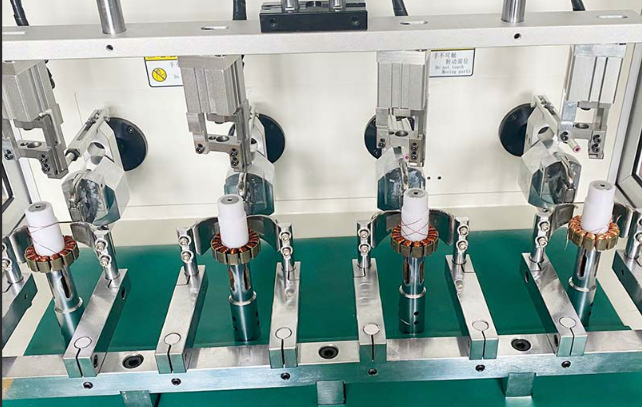What are the contents of the pre-service training for employees of brushless motor motor manual four-station external winding machine?
Brushless motor motor manual four-station external winding machine employee pre-training content:
First, the basic knowledge of equipment
Equipment structure and working principle
Structure composition:
Introduce the overall structure of the winding machine in detail to the employees, including the mechanical parts (such as bobbin, winding head, transmission parts, fixtures, etc.) and the electrical parts (such as motors, sensors, controllers, circuit boards, etc.).
Demonstrate the location and connection of each part so that employees have a clear overall understanding of the equipment.
Working Principle:
Explain the working principle of a brushless motor, including how electromagnetic induction and the interaction of the magnetic field and the electric current realize the rotation of the motor.
Explain how the winding machine drives the bobbin and winding head through the motor, utilizes sensors to realize the control of winding position, tension, speed and number of turns, as well as how the operating instructions of the winding machine are transformed into specific actions through the controller.
Second, operation skill training
1、Operation of power-on and power-off
Power on operation:
Train the staff on the correct steps for powering on the machine, first check whether the environment around the equipment is normal to ensure that there is no debris and no obstacles.
Check whether the power connection is normal, in turn, open the main power switch, start the controller power, wait for the completion of the system self-test, observe the operating panel display is normal.
Shutdown operation:
Teach employees to stop the winding machine after completing the winding task, turn off the controller power supply, and turn off the main power switch behind.
Inform employees to carry out simple cleaning and finishing work on the equipment after shutting down the machine, such as wiping the surface of the equipment and organizing the winding tools.

2、Winding operation
Preparation work before winding:
Instruct employees on how to select appropriate winding materials and winding molds according to different winding tasks, including different wire diameters, materials and spools of different sizes.
Train employees to install and adjust the fixture correctly to ensure that the motor stator or rotor can be firmly fixed on the fixture to ensure the accuracy of the winding position.
Winding Parameter Setting:
Explain how to set the winding parameters on the operation panel, such as the number of winding turns, winding speed, tension setting, starting position, winding direction, etc.
Let employees understand the meaning of each parameter and the impact on the winding results, such as the number of turns determines the number of coils to be wound, the winding speed affects the efficiency and quality of the winding.
Winding process operation:
Demonstrate how to start the winding process manually or automatically, and how to operate the winding head for precise winding, including how to control the start and end positions of the winding.
Emphasis on the winding process to observe the operation status of the winding machine, such as line tension, speed is normal, whether there is abnormal vibration or noise.
Third, equipment maintenance and maintenance
Daily maintenance:
Teach employees how to clean the equipment on a daily basis, including wiping the surface of the equipment, cleaning up winding debris and dust, and using appropriate cleaning tools and cleaning materials.
Train employees on how to check the basic condition of mechanical parts, such as checking the wear and tension of belts, chains, and gears, checking the tightness of fixtures, and checking whether the connections of electrical parts are firm.
Regular Maintenance:
Introduces time intervals and maintenance items for regular maintenance, such as more in-depth weekly or monthly inspections and maintenance of equipment.
Explains in detail how to perform maintenance operations on mechanical parts (e.g., adding lubricant, replacing worn parts) and electrical parts (e.g., checking circuit boards, calibrating sensors).
Fourth, the knowledge and operation of protection
Electrical protection:
Emphasize the importance of electrical protection and explain to employees the risk of electric shock, such as avoiding touching electrically charged parts when the equipment is energized.
Train employees on how to recognize electrical hazard signs, and emergency treatment in the event of an electrical failure (e.g., short circuit, leakage), including cutting off the power supply and the use of fire extinguishers.
Machinery Protection:
Inform employees of possible injuries caused by mechanical parts (e.g., drive components, winding heads, fixtures), such as entrapment and entanglement.
Teach employees to maintain a protective distance when equipment is in operation, follow proper operating procedures when operating, and avoid placing fingers or other body parts near rotating or moving parts.
Personal protective equipment use:
Require employees to properly wear and use personal protective equipment, such as protective eyewear, protective gloves, and coveralls.
Explain the role of different protective equipment, such as protective glasses to prevent foreign objects from splashing into the eyes, protective gloves to avoid hand injuries.
Fifth, fault identification and simple treatment
Fault identification:
Introduce to employees the common fault phenomena that may occur during the operation of the winding machine, such as abnormal winding speed, unstable tension, inaccurate winding position and so on.
Through actual cases and pictures, let employees learn to recognize the performance of different faults, so that they can find the problem in time.
Simple troubleshooting:
Aiming at some common simple faults, such as winding material stuck, operating panel button malfunction, etc., train employees how to deal with them on the spot.
Teach employees how to accurately record the fault phenomenon when encountering unsolvable faults, such as recording the time of occurrence of the fault, the operation steps and fault manifestations, and report them to the supervisor or maintenance personnel in time.
VI. Quality Control and Inspection
Quality standards:
Explain to employees the standards of winding quality, including the accuracy of the number of winding turns, the alignment of the line neatness, tension consistency and other aspects of the requirements.
Show examples of qualified and unqualified winding products, so that employees can intuitively determine whether the quality of winding meets the requirements.
Quality inspection methods:
Train employees how to use simple tools (e.g., calipers, tensiometers) to inspect wire-wound products, such as measuring wire diameter, wire spacing, and tension.
Teach employees how to carry out process inspection during the winding process to detect and correct problems affecting the quality of the winding in a timely manner.
※ If you need any help, please contact the technical specialist of Xinhui Electromechanical Equipment Co., Ltd. via the page chat tool for assistance.







